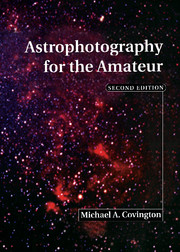Book contents
- Frontmatter
- Dedication
- Contents
- Preface
- Notes to the reader
- Symbols usued in formulae
- I SIMPLE TECHNIQUES
- II ADVANCED TECHNIQUES
- III PHOTOGRAPHIC TECHNOLOGY
- IV DIGITAL IMAGING
- APPENDICES
- A Exposure tables
- B Mathematical analysis of polar-axis misalignment
- C Plans for an electronic drive corrector
- D Film data
- E Photographic filters
- F Organizations and resources
- Bibliography
- Index
E - Photographic filters
Published online by Cambridge University Press: 05 September 2013
- Frontmatter
- Dedication
- Contents
- Preface
- Notes to the reader
- Symbols usued in formulae
- I SIMPLE TECHNIQUES
- II ADVANCED TECHNIQUES
- III PHOTOGRAPHIC TECHNOLOGY
- IV DIGITAL IMAGING
- APPENDICES
- A Exposure tables
- B Mathematical analysis of polar-axis misalignment
- C Plans for an electronic drive corrector
- D Film data
- E Photographic filters
- F Organizations and resources
- Bibliography
- Index
Summary
Most photographic filters are dye filters; that is, they are made of colored glass or of colored gelatin coated on glass or plastic. The table lists most of the dye filters you are likely to encounter; the most useful ones are listed in boldface. Regardless of their color, almost all dye filters transmit infrared wavelengths above 750 nm; that's within the response range of CCDs, silicon-cell exposure meters, and infrared films. That is also why it is not safe to view the sun through ordinary photographic filters.
A filter is considered efficient if it blocks the undesired wavelengths completely while transmitting the desired wavelengths without attenuation. Red, orange, and yellow dye filters are more efficient than those of other colors. Blue dye filters are especially inefficient; they don't transmit all the blue light, nor do they block all the light of other wavelengths.
Interference filters are more efficient than dye filters, but also a great deal more expensive. They use multiple layers of very thin coatings to “tune in” specific wavelengths of light. Nebula filters are interference filters; so are the hydrogen-alpha filters used for narrow-band solar observing. These are discussed on pp. 138 and 102 respectively.
- Type
- Chapter
- Information
- Astrophotography for the Amateur , pp. 307 - 310Publisher: Cambridge University PressPrint publication year: 1999



